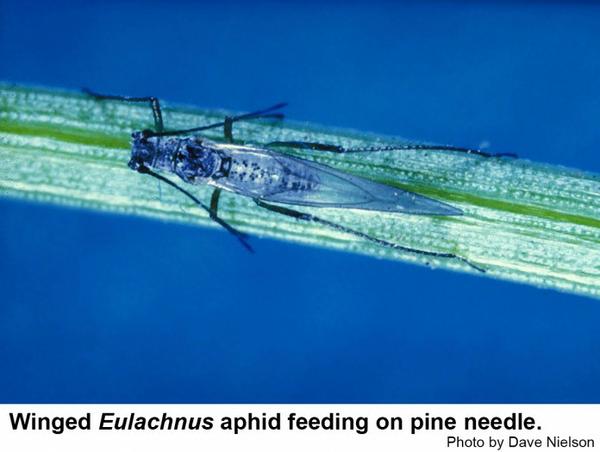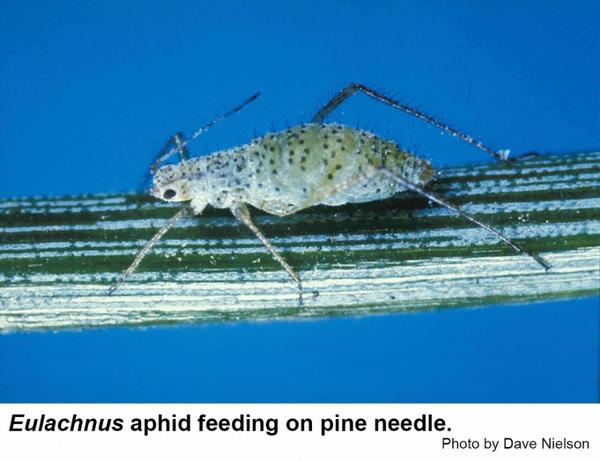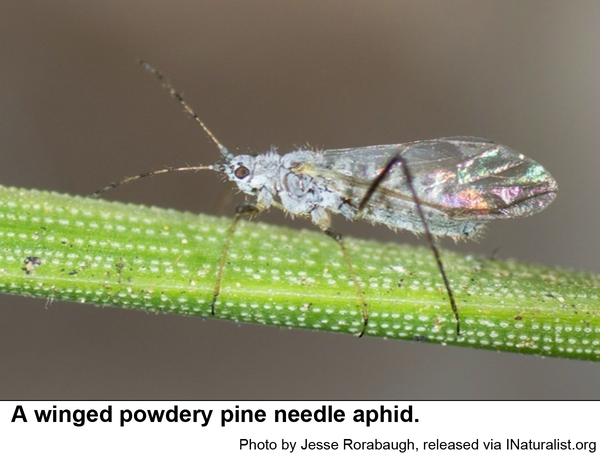Description and Biology
The powdery pine needle aphid, Eulachnus rileyi, is also called the pine need aphid. It and other Eulachnus aphids are small, slender, olive gray insects with relatively long, slender legs and antennae. The body is spindle shaped and usually has some very small dark spots. Among the wingless Eulachnus aphids are those with swollen hind tibiae. Those aphids lay eggs that overwinter on pine although other stages also survive mild winters as well. Some adults have dark wings. In winter, powdery pine needle aphids often become abundant because predators (especially lady beetles and syrphid fly maggots) are less active. Aphid populations can increase dramatically because they can reproduce parthenogenetically and because they migrate into new areas from time to time. In warm weather, parasitic wasps, lady beetles, syrphid fly maggots, lacewings and other predaceous insects feed on aphids so that aphid populations often decrease rapidly then.
Host Plants
Eastern white, loblolly, pitch, red, Scots, shortleaf, slash, and Virginia pines are all susceptible to powdery pine needle aphids. Eulachnus aphids feed only on the needles where they suck out sap that is rich in sugars. They excrete honeydew, a sweet, sticky liquid. Sooty molds grow in honeydew so that heavily infested pines may become noticeably blackened (as well as the grass and other objects underneath).
Residential Recommendation
Should natural enemies fail to keep the aphid population under control, consider spraying one of the horticultural oils as these oils also help to loosen sooty molds. However, oils may remove the waxy bloom that gives white pines and Scots pine their bluish cast. There trees may appear sickly yellow after the application of a oil. Other insecticides labeled for aphid control on home ornamental plants should also give adequate control.
References
- Eulachnus rileyi, (pine needle aphid). Anonymous. 2002 or later. CABI Invasive Species Compendium.
- Insects of Eastern forests. Drooz, A. T. editor. 1985. USDA Forest Service Misc. Publication 1426. 608 pp.
- Aphids on Ornamental Landscape Plants. Steven Frank. 2009. Entomology Insect Notes, NC State Extension Publications.
- Extension Plant Pathology Publications and Factsheets
- Horticultural Science Publications
- North Carolina Agricultural Chemicals Manual
For assistance with a specific problem, contact your local N.C. Cooperative Extension Center.
This Factsheet has not been peer reviewed.
Publication date: Nov. 12, 2013
Reviewed/Revised: Oct. 27, 2023
Recommendations for the use of agricultural chemicals are included in this publication as a convenience to the reader. The use of brand names and any mention or listing of commercial products or services in this publication does not imply endorsement by NC State University or N.C. A&T State University nor discrimination against similar products or services not mentioned. Individuals who use agricultural chemicals are responsible for ensuring that the intended use complies with current regulations and conforms to the product label. Be sure to obtain current information about usage regulations and examine a current product label before applying any chemical. For assistance, contact your local N.C. Cooperative Extension county center.
N.C. Cooperative Extension prohibits discrimination and harassment regardless of age, color, disability, family and marital status, gender identity, national origin, political beliefs, race, religion, sex (including pregnancy), sexual orientation and veteran status.



